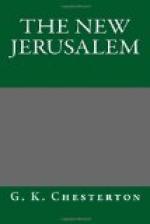When the walls of the Holy City were overthrown for
the glory of the German Emperor, it was hardly even
for that everlasting glory which has been the vision
and the temptation of great men. It was for
the glory of a single day. It was something rather
in the nature of a holiday than anything that could
be even in the most vainglorious sense a heritage.
It did not in the ordinary sense make a monument, or
even a trophy. It destroyed a monument to make
a procession. We might almost say that it destroyed
a trophy to make a triumph. There is the true
barbaric touch in this oblivion of what Jerusalem would
look like a century after, or a year after, or even
the day after. It is this which distinguishes
the savage tribe on the march after a victory from
the civilised army establishing a government, even
if it be a tyranny. Hence the very effect of
it, like the effect of the whole Prussian adventure
in history, remains something negative and even nihilistic.
The Christians made the Church of the Holy Sepulchre
and the Moslems made the Mosque of Omar; but this
is what the most scientific culture made at the end
of the great century of science. It made an enormous
hole. The only positive contribution of the
nineteenth century to the spot is an unnaturally ugly
clock, at the top of an ornamental tower, or a tower
that was meant to be ornamental. It was erected,
I believe, to commemorate the reign of Abdul Hamid;
and it seems perfectly adapted to its purpose, like
one of Sir William Watson’s sonnets on the same
subject. But this object only adds a touch of
triviality to the much more tremendous negative effect
of the gap by the gate. That remains a parable
as well as a puzzle, under all the changing skies of
day and night; with the shadows that gather tinder
the narrow Gate of Humility; and beside it, blank
as daybreak and abrupt as an abyss, the broad road
that has led already to destruction.
The gap remains like a gash, a sort of wound in the
walls; but it only strengthens by contrast the general
sense of their continuity. Save this one angle
where the nineteenth century has entered, the vague
impression of the thirteenth or fourteenth century
rather deepens than dies away. It is supported
more than many would suppose even by the figures that
appear in the gateways or pass in procession under
the walls. The brown Franciscans and the white
Dominicans would alone give some colour to a memory
of the Latin kingdom of Jerusalem; and there are other
examples and effects which are less easily imagined
in the West. Thus as I look down the street,
I see coming out from under an archway a woman wearing
a high white head-dress very like those we have all
seen in a hundred pictures of tournaments or hunting
parties, or the Canterbury Pilgrimage or the Court
of Louis XI. She is as white as a woman of the
North; and it is not, I think, entirely fanciful to
trace a certain freedom and dignity in her movement,
which is quite different at least from the shuffling




